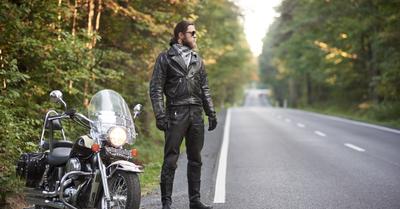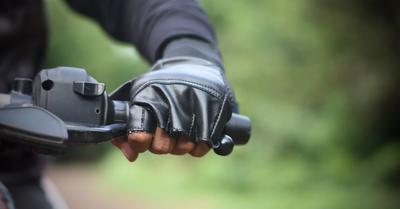What is a Kawasaki Z900 RS?
The Z series of Kawasaki’s line began in 2017 with the introduction of two retro-styles naked bikes designed to get the attention of the motorcycling purist. Powered by a 948cc inline-four capable of 113 hp and 66 lb/ft of torque, the Z doesn't add complicated options to the riding experience. Instead, it prefers the simple thrill of the open road, providing an experience where the motorcycle and the rider are in harmonious bliss, just the rider, the bike, and the pavement stretching out for miles.
Based on the look of motorcycles from the seventies, this is a bike that can be driven in street traffic comfortably or on longer excursions. The retro styling lends itself to a more upright posture, easing the strain on the rider’s back, and the position of the handlebars and the foot pedals lend themselves to an easy, more relaxed ride.
Even though the flat gold finished wheel spokes look nostalgic and complement the nostalgic yellow/black paint scheme, the bike is not without some modern touches. Gone are the mono-bulb headlights and taillights for more advanced LEDs. The instrument screen is multifunctional and very high-tech but still looks the part. The design team at Kawasaki should be commended for staying true to the look of the retro but not being limited in finding a way to incorporate the 21st-century technology that so many riders have come to expect.
The ride is soft and gentle for the most part until the bike is pushed to a limit. Then, under the command of the rider, it becomes a beast. Topping out at 140 mph, the engine will deliver when needed (not that anyone in their right mind would want to ride at that speed with only two wheels on the ground, right?). Don’t let the bike's older looks fool you; this motorcycle has some serious pep in the tank.
What are the Best Tires for a Kawasaki Z900 RS?
There are various manufacturers that produce a quality tires for the Z, depending on what the riding style is. We have listed some of our favorites below.
Dunlop Sportmax Roadsport 2
These are the tires that Kawasaki uses on the 2022 Z900RS as it comes off the assembly line. The tire is a balance of performance and value, designed to provide good traction and grip without wearing out prematurely. The compound uses a formula designed to grip better while braking and provide the firmness needed while leaning into a curve. This is the tire for someone who uses their bike as a daily commuter because the balance it shows is just excellent. The speed rating for the Dunlop Sportmax Roadsport is W - which makes them rated to go 168 mph.
Dunlop is the largest manufacturer of motorcycle accessories and tires in the United States. While they are a British multinational named after the inventor of the pneumatic tire, the company is part of the Goodyear family. They have manufacturing plants worldwide, but this particular tire comes from the factory in Buffalo, NY. .
Pros
- Good tire for higher speeds, but balanced enough for daily commute
- Excellent traction on wet surfaces
- Built in the US
- Reasonably priced - good value for a tire
Cons
- Not a tire for an aggressive driver.
Price
- For more information, check out the manufacturer’s website
- Click here for Today’s Price.
Michelin Road 5
This Michelin tire is a beautiful example of what a universal tire should be. From its excellent wet handling traction to the siping that doesn’t become worse as it wears, this tire will continue to channel water even after years of use. The side walls are thickly constructed to provide confidence in turns and leans. While the tire may be more expensive than other brands, the quality of the workmanship makes it worth the price. The speed rating for the Michelin Road 5 is W (168 mph).
Michelin is a French-based company that is the world's second-largest maker of tires. Their long history of producing quality tires lends itself to years of experience. (Your grandfather might have trusted Michelins. I know mine wouldn’t use anything else). Over the years, the company has expanded its operation to 123 production centers in 26 countries, employing over 124,000 workers worldwide.
Pros
- Good tire for longevity
- Excellent traction on wet surfaces
- Built by a manufacturer that builds lots of tires
- An excellent replacement for OEM
Cons
- Made overseas
- On the expensive side
Price
- For more information, check out the manufacturer’s website
- Click here for Today’s Price
Bridgestone Battlax T32
This tire is built to last with a rich compound that can handle extreme temperature conditions. The siping is cut onto the tread to help evacuate moisture on wet pavement during a turn or lean (which is helpful if you don’t want the bike to come out from underneath you). The tire is moderately priced compared to others like the Michelin so that it won’t break the piggy bank. The speed rating for the Bridgestone Battlax T32 is W (168 mph).
Bridgestone started its company as a producer of rubber hoses and soon found a growing market in the automobile industry. Although it underwent various name changes before merging with Firestone in the 1980s, the company continues to be a primary producer of tires for both motorcycles and cars.
Pros
- Built for long-distance riding
- Longevity is better than most
- Excellent traction on wet surfaces
- Moderately priced
Cons
- Made overseas
Price
- For more information, check out the manufacturer’s website
- Check here for Today’s Price
Metzeler Racetec RR K2
This Racetec RR is your best option for tires if you plan on racing your bike much at all. While the tire is street-legal and can be ridden on the roadway, the compound is specially designed to handle the excessive speeds and the different road surfaces of a road race. The tire is built to handle the stress of racing, elevation changes, and even temperature spikes. .
The RR (Road Racing) tire has a K2 compound which provides some softness for cushioning but enough grip to feel planted when accelerating. The tire also has good treadwear and can hold up even after many miles. The speed rating for the Metzeler Racetec RR K2 is W (168 mph).
Metzeler is a German company owned by Pirelli. This company has been making tires since 1892. While their reputation is excellent in Europe (especially on the racing circuit), the company is less well known in the states. The tires are made in Germany and shipped to the US.
Pros
- Good tire balance built for racers, but still street smart
- Excellent traction on wet surfaces
- Built in Germany - the tire is exact and precise.
- Very popular tire in Europe
Cons
- Made overseas
Price
- For more information, check out the manufacturer’s website
- Click here for Today’s Price.
Pirelli Angel GT II
This Angel GT 2 is a tire with plenty of grip and lasts much longer than many other sporting tires. The tire works very well on wet surfaces and establishes itself during braking or acceleration as the surface contact bites into the pavement. If you need speed, be careful, this tire will get up and go. The name implies that the tire can also withstand heavier loads (should you wish to do cross-country rides or have someone ride with you).
Without a doubt, Pirelli is one of the big players in tire manufacturing. Based out of Milan, Italy, the company has been making tires since the late 1800s. They are the primary supplier of tires for Formula One and other racing circuits. Pirelli has an excellent reputation for building quality tires. Their tires tend to be expensive, but with the longevity that the Angel GT brings, these are worth every penny a rider will spend.
The speed rating for the Pirelli Angel GT2 is V - which means that it can be safely ridden to speeds up to 149 mph.
Pros
- Good sport-touring tire
- Excellent traction on wet surfaces
- Excellent Reputation from a top manufacturer
Cons
- Made overseas
- On the expensive side
Price
- For more information, check out the manufacturer’s website
- Click here for Today’s Price.
Michelin Pilot Power 2CT
Michelin strikes again on our list of excellent tires for the Kawasaki Z900RS. The technology behind the tire is based on MotoGP racing (the company has been very successful in winning a lot of races). The compound uses two rubber formulas, each having its purpose, whether it is a need for straightaway acceleration or a firmer grip when leaning into and speeding out of the curve. (The tire performed at a 51.2-degree angle during testing, which is amazing). The speed rating for the Michelin Pilot Power 2CT is W - 168 mph.
As one of the largest makers of tires in the world, the company offers almost every kind of motorcycle tire imaginable. This sport touring tire is aptly designed for the rider who wants to use their bike both on the street or on the track without having to change tires for each application.
Pros
- Good tire for longevity, based on racing tests
- Excellent traction on wet surfaces
- Built by a manufacturer that builds lots of tires
Cons
- Made overseas
- On the expensive side
Price
- For more information, check out the manufacturer’s website
- Click here for Today’s Price
How Do I Know What My Tire Size is?
The tire size for the 2022 Kawasaki Z900RS differs from the front to the rear. The size is
- Front tire: 120/70 x 17
- Rear tire: 180/55 x 17.
Understanding the code on the side of the tire is easy if you remember that every number or letter on a tire has a corresponding meaning.
The first three numbers (120, 180) indicate the millimeter width of the tire. This is the measurement from sidewall to sidewall.
The following two numbers (70 and 55) indicate the aspect ratio. This is the sidewall measurement as a percentage of the tire's width.
The following letter (usually an R) shows the tire's construction, in this case, radial.
The final number (in our example, 17) is the rim size (in inches).
Separated by space, two numbers and a letter are inside a parenthesis. For example (73W), indicates the load index (this is how much weight the tires can handle, and the speed index (the maximum speed the tires can accommodate).
What are the Weight Restrictions for Motorcycle Tires?
The load index chart demonstrates the load restrictions for motorcycle tires. Here are some reasonably common weight loads for tires, like the ones that fit the Kawasaki ZR900RS.
What are the Speed Restrictions on a Motorcycle Tire?
Most serious riders of motorcycles do not intend to push their bikes to the limit of their speed capacities because they know that traveling at high rates of speed on the street isn’t just illegal; it's an exercise in stupidity. Although excessive speed can create issues, there are limits that a tire can inherently handle.
So, that being said, there are speed restrictions on different types of tires. The information about the speed rating is found in the owner's manual, or on the tire's sidewall. For example, on the factory OEM tire for the Kawasaki, the tire's sidewall will be on various motorcycle tires. In some cases, you will find the rating on the tire's sidewall (referred to as a letter, behind the first series of numbers). A rider should always consult the owner’s manual for their bike or look up the information on the internet. Here is a listing of some other letters and their speed ratings.
Are There Different Types of Tires for Motorcycle Applications?
There are differences in tires depending on the surface of the road or the application of what the motorcycle is used for.
Sport
Sport tires are designed for high-performance motorcycles made from softer compounds. The tire's shape is often more rounded because the circular surface help to retain the surface contact with the pavement when a rider is leaning the bike through a curve. A sport tire will be made with a softer compound of rubber so that when the bike is traveling a straightaway, the rubber can conform to the pavement's surface. The soft feel of the tire means a very smooth ride and cushioning feel. These tires usually do very well on wet pavement as well and can have siping that helps channel water away from the center of the tire to prevent hydroplaning.
Cruiser
Cruiser bikes and cruiser tires (unlike sports bikes) are built for the rider who likes long excursions on the highway. They are designed to do precisely what the name implies, go for a cruise. These tires are not made to be stressed or pushed to their limits. They are simply well-balanced tires. (This is not the tire you want to take to the track).
A cruiser-type tire is generally rated for higher load limits. The sidewalls are constructed with stiffer compounds (sometimes a combination of rubber polymers) to handle higher weights and limits. The tread is more pronounced and thicker because these bikes tend to be driven for more miles for extended periods than other bikes.
Touring
Touring tires are more balanced tire than sport tires. While a sport tire is more circular, the touring tire is flatter and resembles a car tire with different treads and sidewalls. The flat surface will often create better traction on wet and dry pavement. These are tires that are built for longevity and tread wear.
Dual Sport
Dual sport tires are made for motorcycles that perform just as their name suggests, both for the racer and the casual daily commuter. The combination tire must have enough tread to perform well on pavement but enough grip to be used on the track when needed. It is in every way a hybrid-type of a tire. Most dual-sport tires will have some designation (70% street vs. 30% off-road, for example) that will help the purchaser know what side of the fence the manufacturer was leaning toward. Most tire makers construct their Dual Sport tires emphasizing daily driving.
Off-Road
(When I was a kid, motocross was the rage. There was always a kid who came to school with broken bones every week because he wrecked his motorcycle jumping off a mound). Because there is a massive demand for off-road motorcycles, the manufacturers make a tire for just such an application. Off-road or motocross tires are for motorbikes that never see a concrete slab. The tread pattern wraps around the sidewall so the tire can dig into the dirt, especially when going through a muddy curve. The tire must be strong enough to handle jumps and a lot of bumping and abuse.
How Long Do Motorcycle Tires Usually Last?
Generally, a typical motorcycle tire will last up to ten years, depending on how often it is ridden and under what conditions. (If you ride your motorcycle daily, you will want to replace your tires much more frequently).
The problem with tires is that they might look okay but still be bad enough not to be able to ride on. Be cautious of the integrity of a tire you haven’t ridden on lately. Dry rot and deterioration can be the death knell of tires, so it pays to inspect your tires before you hop on to ride.
What are the Signs A Motorcycle Tire Needs Replacing?
There are many signs a rider should look for when inspecting their tires to determine if they need to be replaced.
- The tire doesn’t hold pressure
- The tire is punctured
- The tire shows signs of dry rot
- The tire has a bubble or wart on the surface or sidewall
- The tire is damaged
- The tire isn’t built for your riding needs














